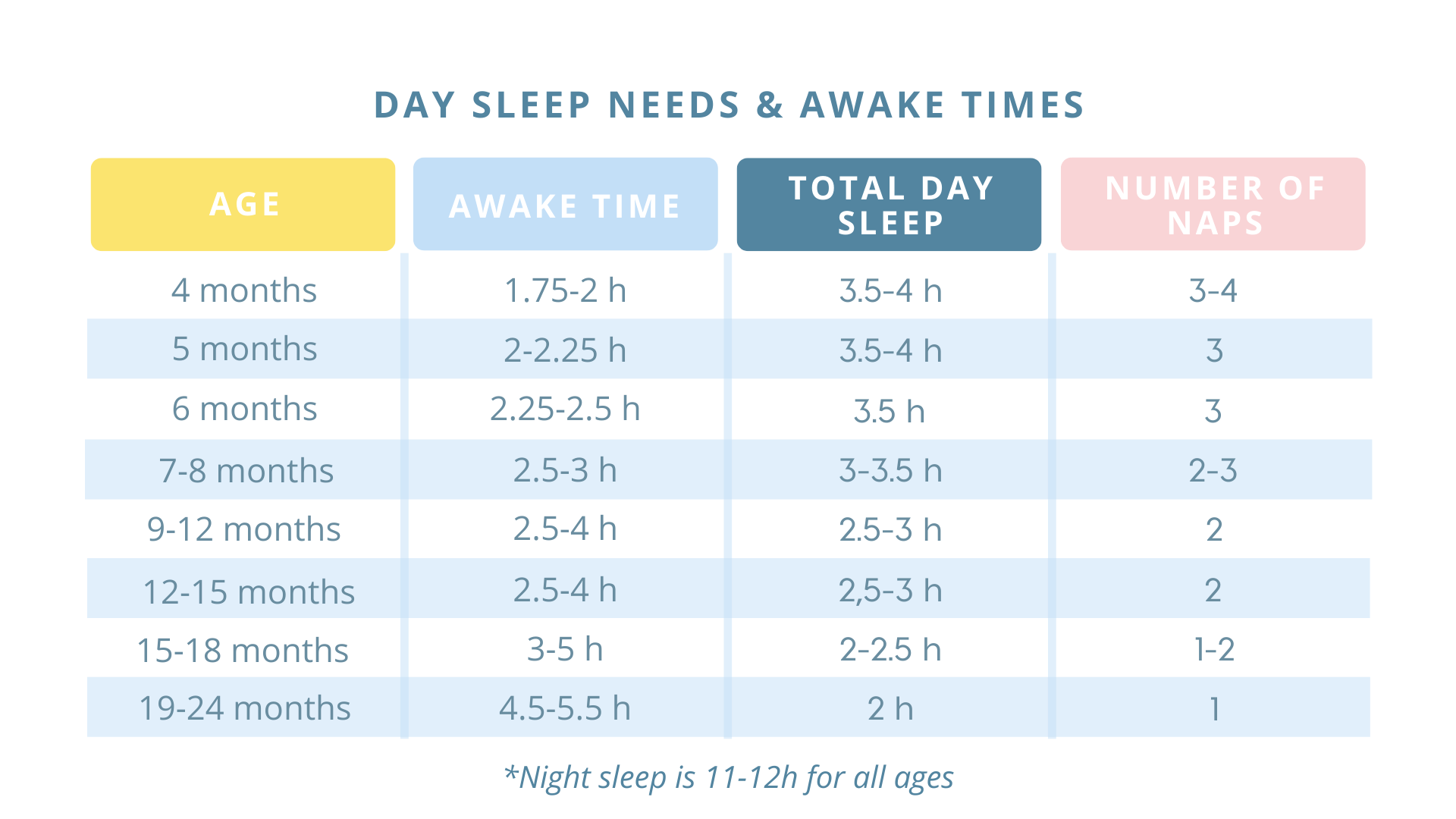Use these 3 simple steps to get your baby sleeping better TODAY!
Apply these tips and you should see changes in just 1-2 days!
1
Set the foundation for good sleep with an age-appropriate day routine
Is your baby…
- waking frequently in the night (often accompanied by crying upon waking)?
- catnapping?
- hard to settle to sleep?
- waking early in the morning?
- being clingy and/or grumpy during the day?
These are all signs that your baby is very likely overtired and that their day routine needs to change.
Day rhythms are not strict schedules and routines that require your baby to follow a rigid system, but rather a predictable sleep-wake pattern.
Creating an age-appropriate day routine:
- ensures your little one gets enough day sleep and that naps are balanced throughout the day, which then encourages good night sleep
- prevents overtiredness and thus promotes longer naps and an easier bedtime
- builds the right amount of sleep pressure to ease falling asleep and boost longer naps
- regulates your child’s circadian rhythm, which promotes overall health + their little body gets used to regular nap and bedtimes, which makes falling asleep much faster and easier
We recommend starting to move towards a regular day rhythm around 3 months (12-16 weeks old).
How to create a day routine for your baby?
The first step is to set your baby’s circadian rhythm by gently waking your baby approximately at the same time every day (say between 7-7:30am or 7:30-8am).
Then, use the information in the following table to create a nap schedule and establish an age-appropriate bedtime (hint: it’s around 12-13h after they wake up in the morning).

Awake time: the amount of time from waking up until back asleep that your child can handle at this age without becoming overtired.
Total day sleep: The amount of sleep your child gets throughout the day, distributed across the number of naps optimal for their age.
Number of naps: this is the optimal number of naps at this age. If your child currently only catnaps and needs more naps, you should work on extending the middle nap to be longer.
Example of an optimal nap schedule for a 4-month-old:
7:00am Wake up
9:00-10:00am NAP
12:00-2:00pm NAP
4:00-5:00pm NAP
7pm Bedtime
Example of an optimal nap schedule for an 8-month-old on 2 naps:
7:00am Wake up
9:30-10:15am NAP
13:15-15:15pm NAP
7pm Bedtime
In our Dreamy Day Routines and the Ultimate Baby and Toddler Sleep Course, we’ll give you sample schedules (and variations) that also include optimal feeding times to ensure that your little one consumes most of their calories throughout the day, rather than at night.
Don’t forget about the bedtime routine!
And a nap routine for that matter.
Bedtime and nap time routines are great ways to signal to your little one that it’s time for sleep. After a few times they will recognize the pattern, and find security in knowing what’s next. You can start with a very simple one as early as 3 months old.
Ideas you can include in your little one’s ritual before sleepy-time:
- Wash face, teeth, change diaper and put on jammies
- Cuddle time and looking at a picture book
- Dim lights and put sleeping bag on
- Hold baby and sing a lullaby
- Turn white noise on
- Lights out and baby into bed
Nap rituals can be short, 5-10 minutes long and bedtime rituals can be a bit longer, 15-20 minutes.
Did you notice we didn’t include feeding as part of the bedtime routine?
We recommend feeding before doing the routine and ending the feed 20-30 minutes before putting your little one in bed (if they’re older than 4 months). This both allows your baby to get the nutrition they need, as well as give them that extra cuddle time before you start your sleep-time ritual.
2
Support good sleep with a sleep-inducing environment
One of the most widespread myths of children’s sleep is that your baby will become a good sleeper ONLY and WHEN you train them to sleep in all sorts of environments (in daylight, around noise, around other people etc) from birth. In reality, the cause and effect have been completely swapped in this equation. You can only ‘train’ a baby to sleep in all sorts of environments, if they are biologically prone to be less sensitive towards outside stimuli. In essence – a good sleeper will sleep well anywhere, but you won’t have a good sleeper just by exposing them to different environments.
Here are some simple facts about sleep and its environment:
- Sensitivity towards their sleep environment (incl. light and/or noise) is mostly caused by your baby’s temperament and genetics, rather than any learnt habits.
- Sensitivity towards the sleep environment increases around 3-4 months of age. Newborns can often sleep anywhere, while older baby’s can’t anymore.
- ALL babies sleep better in an environment that physiologically supports and encourages sleep.
We can’t force our child to fall asleep, nor can we change their biology or development – but we can set the scene for good sleep by optimizing their sleep environment. And the good news is: this can be done easily from the beginning!
How to set up the bedroom for good sleep?
Make it pitch-dark
As in, so dark that you can’t see 1-2 meters in front of your face! This encourages melatonin production, the hormone that makes us feel drowsy. So no light-up toys, baby carousels, fairy lights or any other type of light in your baby’s room.
Use white noise
For children under 1 year and especially during the sensitive newborn stage, using white noise can be extremely helpful. It prevents other household noises (like you ninja-crawling out of the room) from startling the baby out of a deep sleep and actually helps them fall asleep faster (science says so!). White noise should be on for the WHOLE duration of the nap/night sleep and not exceed 50dB in volume.
Keep it cool!
Try to keep the room 19-21 degrees celsius (66-70 fahrenheit).
Bed is for sleep
There shouldn’t be distracting and over-stimulating toys in the baby’s sight and no toys/carousels in or above baby’s bed. After 12 months of age, a cuddle toy or lovey can be a good way to manage separation anxiety.
No night-lights
Babies under 2 years don’t need a night light. If a nightlight is needed for a feed or diaper change, use one with a red/amber hue, and only switch it on for the time you need it.
Sleep environment is one of the easiest things to change and often one of the most overlooked one. Parents often feel that surely, it can’t be THAT easy?! “Surely making the room darker a bit won’t have THAT much effect on our baby’s sleep?” “They sometimes sleep in full daylights so that can’t be the issue..?!” Or “we tried to turn on white noise twice. Nothing changed”.
Sure, ONLY changing your child’s sleep environment can not get you to your desired results, but WITHOUT optimizing the environment in which your baby sleeps, we’re making sleeping well a lot harder for them. After all – what do you have to lose?!
Optimizing their sleep environment is a completely tear-free step towards better sleep and many parents have noted that just by making these changes, things already improve A LOT.
3
Reduce night wakings and achieve long naps with changing sleep associations
Have you ever wondered:
- WHY is my baby waking up after just 10 minutes?
- WHY won’t they sleep more than 30-45 minutes?
- WHY do they wake up every 1.5-2 hours at night?
- WHY do they sometimes wake up even to the quietest noise, but other times nothing can wake them?
All of this can easily be explained by your baby’s sleep cycle.
During the infamous 4-months sleep regression, your baby’s sleep matures and a predictable pattern of sleep cycles emerges during the night (which is why they start waking up every 2h).
Your baby sleeps in predictable sleep cycles that run for 45-minutes during the day and 1,5h-3h during the night.
- Light sleep – The first 10-15 minutes after falling asleep are spent in a very light sleep phase, meaning your little one will be easily woken up by you trying to put them down into the crib, or leaving the room, or any sudden noises in the background.
- Deep sleep – After about 15 minutes, they get into deep sleep. During deep sleep, they can sleep through a marching band practice.
- Light sleep – Towards the end of the sleep cycle, they will transition back into a light sleep phase, and can wake up easily again.
Sleep fact
This means that no baby (nor adult) actually sleeps through the night, but cycles through light sleep stages regularly. A baby that can connect their sleep cycles by themselves will lightly arouse and fall back into a deep sleep. A baby that requires a lot of assistance from their parents to fall asleep and connect their sleep cycles will wake up often in the night to ask for that help once they hit the light sleep stage. This help forms a SLEEP ASSOCIATION.
What’s a sleep association?
Essentially, sleep associations are connections that your little one creates between things+behaviours and falling asleep. These associations can either help or hinder your baby’s ability to fall asleep and/or consolidate (bridge) their sleep cycles during sleep (think short nap vs long nap, or 2-hourly wakings in the night vs sleeping through).
Sleep associations aren’t inherently bad. But in reality, whether they are helpful or unhelpful boils down to if they work for or against your baby’s sleep.
Positive or helpful sleep associations
These either help your child fall asleep, or protect their sleep. They are either constant during sleep, or something the child can recreate on their own when they awaken between sleep cycles.
Examples of positive sleep associations: constant white noise, which protects baby’s sleep from outside noises, and sleeping in a sleep sack, which becomes a non-verbal cue for sleep as well as keeps your baby warm at night.
Negative or unhelpful sleep associations
These are the ones that babies need for settling or falling asleep, but cannot recreate on their own, which means they are unable to move from one sleep cycle to the next without your assistance.
Most common unhelpful sleep associations: nursing to sleep (after newborn stage), rocking/bouncing to sleep, using a dummy (unless they can find and replace it themselves).
To emphasize once more – nursing or rocking to sleep are not bad per se, but may at one point become a stumbling block for long restorative naps and night sleep leading to frequent night wakings+short naps.
The ‘help’ your baby needs can be the same or different every time. For example, it could be that your little one takes all their naps in the moving pram or a carrier, is rocked to sleep with a dummy in their mouth in the evenings, but only settles at the breast during the night. In this case, they have at least 3 unhelpful sleep associations.
If you have already done steps 1 and 2 in this guide, and your little one is still waking up frequently in the night, struggles to take a long nap or wakes up very early in the morning, they most probably have some unhelpful sleep associations.
Want to start sleeping through the night again?
Well, first we have to set some realistic expectations. Did you know that the meaning of ‘sleeping through the night’ varies a LOT according to your baby’s age?
Realistic sleep expectations based on your child’s age:
0-3 MONTHS: one 4-6h stretch per night, 2-4 night feeds
4-8 MONTHS: one 6-8h stretch per night, 1-2 night feeds
9-12 MONTHS: 8-12h night sleep, 0-1 night feeds
over 12 MONTHS: 11-12h night sleep with no feeds
If your baby wakes/feeds more than mentioned above, their sleep CAN be improved!
How, you ask?
Well, by creating an age-appropriate day routine AND sleep-inducing environment, you’re setting a great foundation.
But then it’s time to tackle those unhelpful sleep associations by encouraging your little one to fall asleep and connect their sleep cycles INDEPENDENTLY.
We can help!
Our Ultimate Baby & Toddler Sleep Course will walk you through exactly how to wean sleep associations in a gentle, developmentally appropriate way, with as little tears as possible in order to reduce night wakings, encourage long naps and make bedtime a breeze!

xo, Rachael & Hanna
Rachael is the founder of Sweet Babydreams and a certified baby and toddler sleep coach with over 6 years of hands-on experience helping sleep deprived parents successfully improve their little one’s sleep. Hanna is a psychologist and sleep coach who has worked with over 150 families one-on-one and taught hundreds more through online webinars and sleep courses. Together they form a dream team of experts ready to empower you with the knowledge and tools that will transform your child’s sleep.

